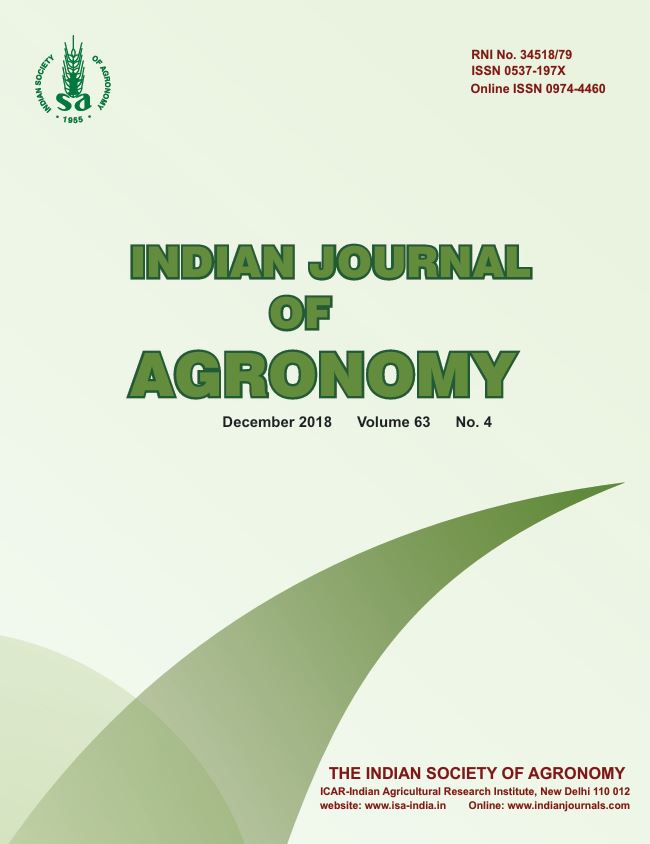Effect of levels and sources of phosphorus on morpho-physiological, seed yield and quality parameters in garden pea (Pisum sativum)
DOI:
https://doi.org/10.59797/ija.v63i4.5683Keywords:
Garden pea, Phosphorus levels, Phosphorus sources, Seed quality, Seed yieldAbstract
A field experiment was conducted during winter (rabi) seasons of 2014–15 and 2015–16 at ICAR–Indian Agricultural Research Institute, New Delhi to study the effect of different levels and sources of phosphorus (P) on growth, seed yield and quality attributes in garden pea [Pisum sativum (L.) hortense]. There were 10 treatments, consisting of 9 combinations of 3 doses (30, 45 and 60 kg P2 O5 /ha) and sources [diammonium phosphate (DAP), single super phosphate (SSP) and rock phosphate (RP)] of P + absolute control, which were laid out in randomized block design with 3 replications. The seeds were treated with phosphorus solubilising bacteria (PSB) and arbuscular mycorrhiza (AM) in the treatment of RP. Results of the study indicated that increase in level of phosphatic fertilizers significantly increased different growth characters, seed yield and seed quality parameters of garden pea. Most of the traits were the highest with 60 kg P2 O5 /ha. Among the different sources of P, RP + PSB + AM resulted in significantly higher yield and quality attributes over control and other P sources and their levels. P-content in seed was also greatly affected by the different doses and sources of P. Protein, P, K and micronutrients content in seed (except zinc) increased with the increase in levels of P. Germination percentage was at par under different treatments. Effect of treatments was also observed on vigour test in normal as well as harsh conditions.
References
Amjad, M., Anjum, M.A. and Akhtar, N. 2004. Influence of phosphorus and potassium supply to the mother plant on seed yield, quality and vigour in pea (Pisum sativum L.). Asian Journal of Plant Science 3(1): 108–113.
Anonymous. 1999. Effects of phosphorus on crop maturity. Better Crops 83(1): 14–19.
Berg, J.M., Tymoczko, J.L. and Stryer, L. 2002. Biochemistry. Fifth Ed. W.H. Freeman and Co.
Blackburn, G.M. 2006. Nucleic Acids in Chemistry and Biology. London, The Royal Society.
Chattopadhyay, A. and Dutta, D. 2003. Response of vegetable cowpea to phosphorus and bio-fertilizers in old alluvial zone of West Bengal. Legume Research 26(3): 196–199.
Drew, M.C. 1975. Comparison of the effects of a localized supply of phosphate, nitrate, ammonium and potassium on the growth of the seminal root system, and the shoot in barley. New Phytologist 75(3): 479–490.
Dubey, S.K. 1997. Co-inoculation of phosphorus bacteria with Bradyrhizobium japonicum to increase phosphate availability to rainfed soybean in vertisol. Journal of the Indian Society of Soil Science 45(3): 506–509.
Fujita, Y., Venterink, H.O. and P. van Bodegom, M. 2014. Lower investment in sexual reproduction threatens plants adapted to phosphorus limitation. Nature 505: 82–86.
Gordon, W.B. 2003. Nitrogen and phosphorus management for corn and soybean in rotation. Better Crops 87(1): 4–5.
Gupta, C.R., Senger, S.S. and Singh, J. 2000. Growth and yield of table pea (Pisum sativum L.) as influenced by levels of phosphorus and lime in acidic soil. Vegetable Science 27(1): 101–102.
Kandil, H. 2014. Response of pea plants (Pisum sativum L.) to phosphorus levels and humic acid levels. International Conference of Agricultural Engineering, 6–10 July 2014, Zurich, P0136.
Kandil, H., Gad, N. and Magdi T.A. 2013. Effects of different rates of phosphorus and molybdenum application on two varieties of common bean (Phaseolus vulgaris L.). Journal of Agricultural and Food Technology 3(3): 8–16.
Kumar, V., Kumar, A., Singh, M.K., Kumar, M. and Kumar, U. 2017. Growth and yield of pea (Pisum sativum L.) cv. Azad P-1 as influenced by NADEP composts prepared by using different raw materials. International Journal of Current Microbiology and Applied Sciences 6(11): 2,260–2,267.
Majumdar, S.P., Indoria, A.K. and Majumdar, V.L. 2004. Effect of levels of compaction, nitrogen and phosphorus on the performance of cowpea on typic ustipsamments. Indian Journal of Pulses Research 17(1): 86–88.
Mishra, S.K. 1999. Effect of nitrogen, phosphorus and seed inoculation on vegetable cowpea (Vigna sinensis Savi.) Annals of Agricultural Research 20(3): 308–312.
Mullins, G.L., Hajek B.F. and Wood C.W. 1996. Phosphorus in agriculture. Bulletin No. 2. Department of Agronomy and Soils, Auburn, USA.
Negi, S., Singh, R.V. and Dwivedi, D.K. 2006. Effect of biofertilizers, nutrient sources and lime on growth and yield of garden pea. Legume Research 29(4): 282–285.
Pandey, D., Singh, J.P., Kashyap, N. and Dwivedi, G.K. 2003. Response of vesicular arbuscular mycorrhyzae (VAM), Rhizobium and phosphrous sources on nodulation, growth, yield of pea cv. VL-7. Crop Research 25(2): 333–336.
Rathi, G.S., Sharma, R.S. and Sachidanand, B. 1993. Effect of irrigation and phosphorus levels on protein content and uptake of nutrients in field pea (Pisum sativum). Journal of Soils and Crops 3: 80–83.
Salisbury, F.B., and Ross, C.W. 1992. Plant Physiology. New Delhi, CBS Publishers and Distributors.
Sammauria, R., Yadav, R.S. and Nagar, K.C. 2009. Performance of clusterbean (Cyamopsis tetragonoloba) as influenced by nitrogen and phosphorus fertilization and biofertilizers in western Rajasthan. Indian Journal of Agronomy 54(3): 319–323.
Shrivastava, T.K. and Ahlawat, I.P.S. 1995. Response of pea to phosphorus, molybdenum and biofertilizers. Indian Journal of Agronomy 40(4): 630–635.
Shukla, Y.R. and Kohli, U.K. 1991. Influence of varieties and phosphorus fertilization on the seed vigour of garden peas (Pisum sativum L.). Annals of Agricultural Research 12(3): 284–287.
Verma, P.D., Swaroop, N., Upadhyay, Y., Swamy, A. and Dhruw, S.S. 2018. Role of phosphorus, zinc and Rhizobium on growth and yield of field pea (Pisum sativum L.) var Rachna. Journal of Pharmacognosy and Phytochemistry 7(1): 1,479–1,492.
Vikrant, S.H., Malik, C.V.S. and Singh, B.P. 2005. Grain yield and protein content of cowpea as influenced by farm yard manures and phosphorus application. Indian Journal of Pulses Research 18(2): 250–251.
Zhang, J. and Barber, S.A. 1992. Maize root distribution between phosphorus fertilized and unfertilized soil. Soil Science Society of America Journal 56(3): 819–822.






